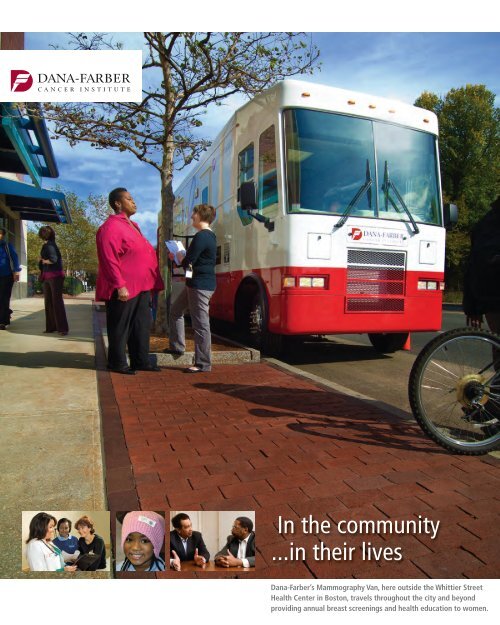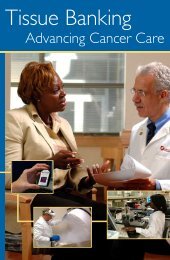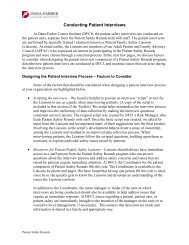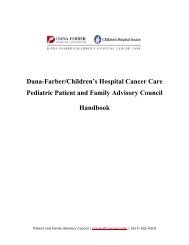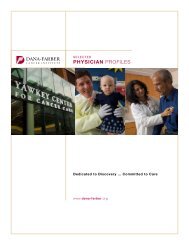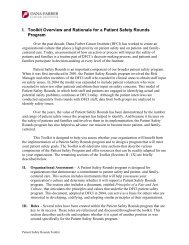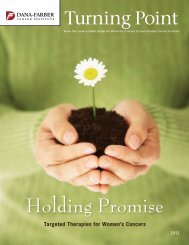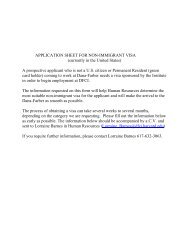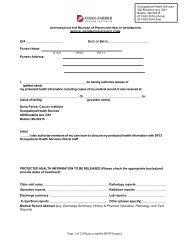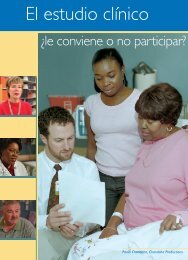Fast Fact - Dana-Farber Cancer Institute
Fast Fact - Dana-Farber Cancer Institute
Fast Fact - Dana-Farber Cancer Institute
You also want an ePaper? Increase the reach of your titles
YUMPU automatically turns print PDFs into web optimized ePapers that Google loves.
In the community...in their lives<strong>Dana</strong>-<strong>Farber</strong>’s Mammography Van, here outside the Whittier StreetHealth Center in Boston, travels throughout the city and beyondproviding annual breast screenings and health education to women.
Who We AreHelping Meet the NeedWhen the City of Boston launched a major initiativeagainst cancer several years ago, <strong>Dana</strong>-<strong>Farber</strong> was at the centerof this effort to educate residents about the disease and improveaccess to our clinical programs. Today we are still at thecenter. As an integral part of our mission to offer expert, compassionatecare for cancer and related diseases while seekingtomorrow’s cures through research, <strong>Dana</strong>-<strong>Farber</strong> is committedto designing public health programs that reduce cancer risk among medicallyunderserved and at-risk communities in Greater Boston and beyond. This focus,embraced and endorsed by our board of trustees and executive leadership, is realizedthrough a range of programs that put us in regular contact with the people whoneed our help most – and can best teach us about the challenges facing them.On the pages that follow, you will get a glimpse of the many ways <strong>Dana</strong>-<strong>Farber</strong> isreaching out to, and partnering with, community residents. Our mobile healthvans travel everywhere from community health centers to housing developmentsto beaches offering prevention tips and screenings, as do our physicians and caregiversthrough survivorship clinics. Staff from our Center for Community-BasedResearch work with citizen groups to create smoking cessation, sun safety, andother cancer-reduction programs. Our commitment to training the next generationof doctors, nurses, and scientists as a teaching affiliate of Harvard MedicalSchool extends far beyond that institution through internships and summer jobsthat expose area high school and college students – many of them from at-risk orunderserved communities – to professional opportunities available in health care. Alongwith opening students’ eyes to exciting possibilities, these and other efforts are aimedat increasing the diversity of <strong>Dana</strong>-<strong>Farber</strong>’s workforce and patient population.Just as we remain committed to curing cancer, we are focused on making sure<strong>Dana</strong>-<strong>Farber</strong> is a welcoming environment for everybody facing cancer today.Edward J. Benz Jr., MDPresident, <strong>Dana</strong>-<strong>Farber</strong> <strong>Cancer</strong> <strong>Institute</strong>
COMMUNITY BENEFITS51116232234468810121214161618202022Who We AreCommunity Benefits OverviewSpreading the WordEducation and OutreachFighting <strong>Cancer</strong> on Four WheelsPartnering on Colon <strong>Cancer</strong> Screening<strong>Cancer</strong> DisparitiesMen Reach Out to MenMinority Scientists Seek to Reduce DisparitiesSchool Partnerships andWorkforce DevelopmentConnecting Nurses to <strong>Cancer</strong>, CommunityFrom Classroom to <strong>Cancer</strong> CenterResearch and Prevention in ActionCollaborating and CommunicatingA <strong>Cancer</strong> Prevention DilemmaTreatment and SurvivorshipPatient Navigators Smooth Path to CareMeeting the Needs of Inner-City <strong>Cancer</strong> Survivors24 Community Partnerships25 About <strong>Dana</strong>-<strong>Farber</strong>COMMUNITY BENEFITS 1
Who We AreCommunity Benefits<strong>Dana</strong>-<strong>Farber</strong>’s Community Benefits leadershipincludes (left to right) NoreenBurke, Anne Levine, Elizabeth GonzalezSuarez, and Athene Wilson-Glover.More informationTo learn more about <strong>Dana</strong>-<strong>Farber</strong>’sCommunity Benefits efforts, go towww.dana-farber.org/communitybenefits, or call 617-632-4433.The role of <strong>Dana</strong>-<strong>Farber</strong>’s Community Benefits office is tosupport the <strong>Institute</strong>’s goal to reduce cancer risk among medically underservedpopulations. To that end, we work with city and state health departments,community partners, and Boston-based coalitions to assess and monitor theneeds of local residents with respect to cancer control. In collaboration withstaff throughout <strong>Dana</strong>-<strong>Farber</strong>, we serve as a bridge with community organizationsand establish evidence-based and sustainable outreach programs.We are on the front lines of supporting and collaborating on many of theprograms described in this publication – programs designed to eliminatedisparities in breast, colon, and prostate cancer; educate diverse populationsabout clinical trials; and strengthen the support system for medicallyunderserved populations. In short, we are committed to making<strong>Dana</strong>-<strong>Farber</strong>’s care and research findings more accessible to everyonewithin and outside its walls.2 www.dana-farber.org
Spreading the WordWhen Magnolia Contreras, MSW, MBA, steps intoa senior center in Roxbury, Mass., to discuss upcomingcancer-prevention workshops, she is not only spreadingthe word about <strong>Dana</strong>-<strong>Farber</strong> to low-income elders – sheis laying the foundation for future relationships.“My role is to ensure that people know about <strong>Dana</strong>-<strong>Farber</strong> and the services we can provide,” says Contreras,director of Community Benefits at DFCI. “We wantpeople to feel comfortable walking through our doorsand obtaining the high-quality and comprehensiveclinical and support services they deserve.”Contreras works with other health care institutions,local and state organizations, and many <strong>Dana</strong>-<strong>Farber</strong>colleagues to raise awareness about risk, prevention,and early detection of cancer and related diseases suchas AIDS. Her aim is to keep the <strong>Institute</strong> as visible aspossible among groups who have traditionally facedbarriers to obtaining health care in Boston, includingAfrican-Americans, Latinos, and people with low incomesor disabilities. Visibility might mean providingsustainable prevention programs through communitypartnerships such as co-sponsoring a health fair, promotingsun safety at a local beach through a visit bythe Blum Family Resource Center Van, or encouragingmen at higher risk for prostate cancer to get tested.“A cancer screening is more than a screening,” Contrerasreasons. “It’s an opportunity to give people cancerprevention information that could save their lives.”Well-versed in community health and public policyissues, Contreras also teaches courses in grant proposalwriting and public policy at Salem [Mass.] State College’sGraduate School of Social Work and helps lead acommunity cancer coalition in Boston. “Magnolia isvery resourceful and understands the challenges differentneighborhoods face,” says AlmaPetrovic, MD, MPH, formercommunity director of publichealth initiatives at the WhittierStreet Health Center in Roxbury,where <strong>Dana</strong>-<strong>Farber</strong> runsa monthly survivorship clinic.“She’s somebody you cancompletely rely on.”And, as a breast cancer survivor,Contreras brings a personalperspective to her mission. “Havinghad a smooth ride in mydiagnosis and treatment,” shereflects, “I want to make sure othershave that same experience.”COMMUNITY BENEFITS 3
Education and OutreachFighting <strong>Cancer</strong> on Four Wheels<strong>Fast</strong> <strong>Fact</strong>s:Mammography Van by the Numbers25,000+3,968806340+When Marianne (not her real name), a40-year-old woman from Dorchester, Mass.,took the first steps toward detecting her stage 1breast cancer, it wasn’t in her doctor’s office.It was on four wheels. The screening that firstdetected an abnormality in Marianne’s breastwas conducted on <strong>Dana</strong>-<strong>Farber</strong>’s MammographyVan, which provides annual breastscreenings and health education to womenthroughout the Greater Boston area.The mammography van is the only vehicleof its kind in Massachusetts. It providesmammograms to all women who requestone, regardless of their ability to pay.Nearly a quarter of the approximately4,000 women who visit the van each yearfor the 15-minute procedure don’t haveNumber of mammograms the van has providedsince its inception in 2002.Number of mammograms conducted on Boston’sMammography Van in fiscal year 2009.Percentage of women of ethnic minority backgroundswho receive annual screenings on the van.Number of women (through fiscal 2009) who havereceived a confirmed diagnosis of breast cancer afteran initial screening on Boston’s Mammography Van.<strong>Dana</strong>-<strong>Farber</strong> partnerships with community healthcenters involving the van.health insurance. These women are encouragedto apply for insurance, and those without aprimary care physician can find one with helpfrom van staff members.“The mammography van provides a sourceof screenings and education for women whooften don’t have easy access to such services,”says Melissa Saporetti, program manager forthe van. “Many of the women we see are uninsured,low-income, elderly, immigrant, non-English speaking, or of other ethnic or racialminority backgrounds. We’re a real lifeline forthese women.”Van visits have increased each year. In2009, around 64 percent of patients werereturning to the van for an annual mammogram,which shows that the service helpswomen continually monitor their breasthealth and stay connected to the health caresystem. The 38-foot-long vehicle is fitted withGE Healthcare’s Senographe Essential ® digitalmammography system, which provides thesame high level of image quality that patientsreceive at <strong>Dana</strong>-<strong>Farber</strong>, says Jack Meyer, MD,director of Breast Imaging at DFCI.4 www.dana-farber.org
Driving toward improved careThe mammography van is part of a Mobile Health program at <strong>Dana</strong>-<strong>Farber</strong>that also includes the Blum Family Resource Center Van, a rolling classroom thattraverses the streets providing services including prostate screenings and education,sun safety education, skin cancer screenings, and outreach on the HPV (humanpapillomavirus) that causes cervical cancer. The van’s mission is to lower healthdisparities in cancer incidence by increasing education and access to early detectionand screening opportunities. Research shows that communities of color tend toreceive a cancer diagnosis at later stages of the disease.If a possible cancer is detected during a screening on either van, <strong>Dana</strong>-<strong>Farber</strong> staff members take action to ensure that the patient seeks follow-upcare from a trained health care professional.“Working together, both the Blum Family Resource Center Van and themammography van deliver vital health screenings, outreach, and educationto men and women throughout the Boston area, particularly in underservedneighborhoods,” says Noreen Burke, director of Mobile Health, <strong>Dana</strong>-<strong>Farber</strong>.“They are a testament to the <strong>Institute</strong>’s longstanding commitment to bringcancer prevention and care into the community.”Learn more about the mammography van online at www.dana-farber.org/mammographyvan, and the Blum van at www.dana-farber.org/blumvan.Above, the Blum Family Resource Vanvisits the Massachusetts State House.At left, Valerie Wilson (foreground) isprepared for a breast screening on<strong>Dana</strong>-<strong>Farber</strong>’s Mammography Van byMobile Mammography TechnologistDonna Orlando.COMMUNITY BENEFITS 5
Education and Outreach<strong>Dana</strong>-<strong>Farber</strong> Partners withCommunities on Colon <strong>Cancer</strong> ScreeningPeer leaders from Bostonareahousing developmentsteach fellow residents howto reduce their risk forcolon cancer and getscreened for the disease.<strong>Dana</strong>-<strong>Farber</strong> is bringing fresh momentum to a community outreachprogram aimed at increasing colorectal cancer screening rates among racialand ethnic minority groups in the Boston area.The program, dubbed Open Doors to Health, has trained residents of locallow-income housing complexes to be “peer leaders” who help fellow residentsreduce their risk for colorectal cancer and get screened for the disease at localhospitals. In addition, a “patient navigator” aids residents in overcoming someof the obstacles to getting a colonoscopy exam, in which a doctor views theinterior of the colon with a flexible scope.6 www.dana-farber.org
Neighborhood peer leaders,here meeting at the GrantManor Apartments in Boston,are united in their efforts.The project expands an ongoing study that began in2003 in 12 housing sites throughout Greater Boston. Six ofthe sites initially had peer leaders, who supported residentsin increasing their level of physical activity and helped buildawareness of the importance of colorectal cancer screening,particularly among residents over age 50 and those with afamily history of the disease. The other six sites receivedpamphlets on the value of screening and physical activity,but didn’t have peer leaders. Residents of all the siteswere given streamlined access to screening services, includingthose at Brigham and Women’s Hospital (BWH).The study compares physical activity levels and colorectalcancer screening rates at the peer leader and information-onlysites. Although the results are still beinganalyzed, it’s clear that “the peer leaders have had a verypositive influence in their communities,” says KarenEmmons, PhD, deputy director of <strong>Dana</strong>-<strong>Farber</strong>’s Centerfor Community-Based Research and principal investigatoron the Open Doors to Health project.Did you know?Only half of men and women over the age of 50 inthe United States are currently being screened forcolorectal cancer, despite the test’s proven abilityto reduce deaths associated with this disease.The expanded project includes training for peer leadersat the sites previously without them and the addition of apatient navigator to work closely with residents at all participatingsites, as well as with patients at two communityhealth centers in Boston’s Jamaica Plain neighborhood.Supported by the <strong>Dana</strong>-<strong>Farber</strong>/Brigham and Women’s<strong>Cancer</strong> Center, the navigator promotes colon cancer screeningand improves access to screening centers by helpingpeople overcome common barriers to these services.One such barrier, inadequate preparation for the procedure,is addressed by helping residents and patientsunderstand the preparation instructions. The navigator’srole involves ensuring that residents have transportationto and from their appointments, meeting with them toallay their concerns about screenings, and working withhospital staff to coordinate follow-up services. Thisapproach can produce better outcomes for patients andreduce the costs associated with improper preparationand high no-show rates for colonoscopies.“We’ve found that while pamphlets and peer leadersare helpful for encouraging people to schedule colorectalcancer screenings, many people fail to prepare properlyor are unable to make their appointment because oftransportation issues,” says Wanda McClain, executivedirector of Community Health and Health Equity atBWH. “There is evidence, both from research and otherpatient navigator programs, that navigators can increasescreening rates in this population.”COMMUNITY BENEFITS 7
<strong>Cancer</strong> DisparitiesProstate <strong>Cancer</strong>: Men Reach Out to MenEarly in the evening each month about 35 men arriveat <strong>Dana</strong>-<strong>Farber</strong> for a prostate cancer support group,including Richard Salmon. An assistant principal atBoston’s Martin Luther King Jr. Middle School and thefather of six grown children, Salmon says, “I love thegroup. You have to get over being macho and rememberprostate cancer kills black men twice as often as whitemen. It’s important to be proactive.“Am I right, guys?” he asks the other men filing in,and they nod in agreement.A four-time cancer survivor – three bouts with coloncancer and one with prostate – Salmon also lost his fatherand two brothers to the disease. Still, he says, “You can’tlet cancer control you.”During the meetings, which have taken place since2005, men often speak about their concerns with adirectness that they may have withheld from eventheir closest family members. They also benefit fromspeakers who discuss the latest treatments and offertips for self-care, such as good nutrition.As the number four killer of African-American men,prostate cancer is a major focus of <strong>Dana</strong>-<strong>Farber</strong>’s effortsto reduce cancer disparities. Through collaborationswith community-based organizations, the <strong>Institute</strong> offers8 www.dana-farber.org
At left, in the men’s support grouphe facilitates, Tom Farrington (right)informs and inspires participantsincluding Richard Salmon.education, screening, patient navigation, and support,both within and beyond the Blum Patient and FamilyResource Van (see p. 4). These programs are led by healtheducator Mark Kennedy and Jacques Carter, MD, MPH;Not only are the efforts designed to help men prevent thedisease or discover it early, but patients and survivors canalso find encouragement and friendship.The support group’s leader is Thomas Farrington,a prostate cancer survivor and founder and presidentof Boston’s Prostate Health Education Network(PHEN). In his writings, lectures, and internet postings,the straight-talking Farrington – who is alsoan author and <strong>Dana</strong>-<strong>Farber</strong> Trustee – charges eachman to protect his prostate health, armed withknowledge about his body.As he arrives on this night, he asks one participantabout his recent score. “Eight,” the man says, referringto his PSA (or prostate-specific antigen) screening.“No, I mean golf,” jokes Farrington.Watching the room begin to fill with conversationsand laughter, Salmon says the support group provideslessons in courage. “You learn that you can createchange. You can face your own cancer bravely andreach out to other men.”Did you know?African-American men have the highest incidenceof prostate cancer in the United States and are morethan twice as likely as Caucasian men to die of thedisease, according to the National <strong>Cancer</strong> <strong>Institute</strong>.Fighting Disparities Through FaithFaith can be a powerful ally for those fighting a dauntingdisease. In her roles as community outreach coordinatorat <strong>Dana</strong>-<strong>Farber</strong> and former director of the Greater Bostonchapter of The National Black Leadership Initiative on <strong>Cancer</strong>,Athene Wilson-Glover (above, with her pastor, WilliamE. Dickerson II) has worked with area houses of worship tohelp change the fact that blacks are more likely to developcancer, and die from it, than whites.Through one initiative, the Faith-Based <strong>Cancer</strong> DisparitiesNetwork, <strong>Dana</strong>-<strong>Farber</strong>/Harvard <strong>Cancer</strong> Center and theBlack Ministerial Alliance of Greater Boston hold resourcefairs targeting local pastors and parishioners to educatethem about cancer and the local resources open to churchcongregants. Wilson-Glover also organizes visits to faithbasedorganizations by <strong>Dana</strong>-<strong>Farber</strong>’s Mobile Health programs(see p. 4), as well as an annual “Week of Prayer”during which pastors offer spiritual guidance to those battlingthe disease. “Everybody has been touched by cancerin some way,” says Wilson-Glover, “and I am committed toletting people know where to go for screening and care.”So is Dickerson, a Black Ministerial Alliance member seenhere with Wilson-Glover at their church, Greater LoveTabernacle in Boston’s Dorchester neighborhood.COMMUNITY BENEFITS 9
<strong>Cancer</strong> DisparitiesMinority Scientists Seek to Reduce DisparitiesWhen Danielle Byrdsong was growing up in Boston,she loved watching science-related TV shows such as “BillNye the Science Guy.” It didn’t matter to her that Bill andthe other “mad scientists” she admired were white men.Today, Byrdsong offers a different model as she comesto work each day in <strong>Dana</strong>-<strong>Farber</strong>’s NIH-funded Centerfor Excellence in Genomic Science (CEGS) and engagesin cutting-edge cancer research. She is one of four collegegraduates enrolled in a program that offers minority “postbaccs” (short for “baccalaureate,” a bachelor’s degree) atwo-year, hands-on experience in the sciences, enhancingtheir chances for admission to graduate school.The word disparity once meant very little to Byrdsong,whose mother always encouraged her interest in science.She graduated from the John D. O’Bryant School of Mathematicsand Science in Boston and earned a degree in biology,with a minor in chemistry, from Simmons College.In college she began to notice how unusual she was.“Throughout my various lab experiences there was notone person who looked like me, anywhere,” she recalls.“The first black woman scientist I ever met was mymentor through the CURE [Continuing Umbrella ofResearch Experiences] program [see p. 15]. Meeting herwas a turning point for me.” Through CURE, Byrdsongworked with Kafi Meadows, PhD, a research fellow invascular biology at Beth Israel Deaconess Medical Center.The word disparity means a great deal, however, toKaren Burns White, deputy associate director of the Initiativeto Eliminate <strong>Cancer</strong> Disparities (IECD) within the<strong>Dana</strong>-<strong>Farber</strong>/Harvard <strong>Cancer</strong> Center (DF/HCC). BurnsWhite knew that Byrdsong could one day offer the sameinspiration to others that Meadows provided for her.The post-baccs benefit from a collaboration that includes<strong>Dana</strong>-<strong>Farber</strong> and four other Boston institutions: Brighamand Woman’s Hospital, Harvard Medical School, HarvardSchool of Public Health, and Northeastern University.In addition to the post-bacc program, <strong>Dana</strong>-<strong>Farber</strong> isengaged in many other initiatives to address cancer healthdisparities. Recent examples include an effort to bringcancer education and resources to faith-based communities(see p. 9); a partnership with the University of MassachusettsBoston, New England’s most diverse public four-yearcollege, which helps students and faculty obtain cancerresearch positions and internships (see p. 12); and opportunitiesfor minorities to receive hands-on educationaland professional development, mentoring, networking,and access to local and national educational conferences.Sisters Karen Burns White (left) and Candace Burns Johnson arehelping create a pipeline of minority scientists to <strong>Dana</strong>-<strong>Farber</strong>.10 www.dana-farber.org
“The first black woman scientist I ever met was my mentor throughthe CURE program. Meeting her was a turning point for me.”— Danielle ByrdsongThe first post-bacc to enroll in the CEGS program,Byrdsong is part of a multifaceted effort to build apipeline of minority scientists choosing cancer research,explains Burns White. “We believe it will take a cadre ofscientists from under-represented ethnic and economicgroups to help us reduce disparities and inspire futurescientists,” she says.Looking forward, Byrdsong plans to apply to severalgraduate schools and earn a PhD in molecular geneticsand microbiology. And looking back, she intends to serveas a mentor to girls in high school. “I want them to knowthat if they’re interested in science they don’t have to becomea doctor or a nurse. Many other related careers areopen to them.”To read more about the DF/HCC’s commitment toeliminate cancer disparities, visit www.dfhcc.harvard.edu/center-initiatives/iecd/.Danielle Byrdsong (foreground) and other college graduates(left to right, Robert James, Venus Swearingen, and MelissaDuarte) are gaining experience as scientists before attendinggraduate school.<strong>Fast</strong> <strong>Fact</strong>Black scientists represent just 1 percent of alltenured investigators at the National <strong>Institute</strong>sof Health and 1.5 percent of investigators ina tenure track, according to a 2007 studypublished in The Scientist.COMMUNITY BENEFITS 11
School Partnerships and Workforce DevelopmentConnecting Nursesto <strong>Cancer</strong>, CommunitySince 2005, <strong>Dana</strong>-<strong>Farber</strong> has partnered with the Universityof Massachusetts Boston (UMB) to reduce healthdisparities in Boston neighborhoods and diversify theregion’s biomedical leadership. Through funding from aNational <strong>Institute</strong>s of Health U-56 grant – which linksinstitutions that serve minorities with Comprehensive<strong>Cancer</strong> Centers – the two organizations provide learningand outreach opportunities for multicultural students.<strong>Fast</strong> <strong>Fact</strong>Approximately 15 percent of registered nurses aremembers of minority groups, compared to one-thirdof the American population.Each semester, eight students Nursing student Ruthfrom the UMB College of Nursing Elineema (center) observesas preceptor Debraand Health Sciences come to <strong>Dana</strong>- LaFrankie consults with<strong>Farber</strong> to complete a community patient Cynthia Thomas.health rotation. Instructor and<strong>Dana</strong>-<strong>Farber</strong> Clinical Nurse Specialist Susanne Conley,RN, MSN, points out that while DFCI does not offer atraditional community health experience, the <strong>Institute</strong> providesstudents with a unique opportunity to look at canceras a disease that affects all communities, with an eye towarddisparities. “We talk about clinical trials, and also lookat how prevalent diseases are in different cultures,” saysConley. “The fact that cancer survival rates for Caucasiansare much higher really resonates with the students, sincemany of them come from multicultural backgrounds.”In addition to classroom time with Conley, the aspiringnurses spend one day per week with DFCI nursing12 www.dana-farber.org
preceptors including Debra LaFrankie, RN, who mentorthem as they practice procedures and patient assessments.LaFrankie worked alongside Ruth Elineema, a UMBsenior and native of Tanzania. Shy at first, Elineema graduallybecame more confident in her examination skills, andher opinion was well respected among members of hercare team. “When you’ve worked for a long time in anoncology specialty it’s good to get another perspective;the students help us see things from the patient’s standpoint,”says LaFrankie, a program nurse in Neuro-Oncology.“I think Ruth is going to be an excellent nurse.”As part of the course in the past, students have alsobeen able to work on a community outreach project.During one semester, for example, the students taughtSouth Boston third graders about the risks of smoking.Another nursing venture being funded by the grantis an accelerated Bachelor of Science-to-PhD program.Focusing on cancer care and health disparities, thecurriculum takes graduate-level nurses outside of thetraditional hospital environment and introduces themto nursing research and health policy.The accelerated program addresses a problem that someare calling a public health crisis: a shortage of faculty atnursing schools across the country. This is compoundedby a scarcity of minorities in the profession.“We’re hoping to attract more minority students tocareers in nursing, provide added training in communitysettings, and enable students to conduct research with<strong>Dana</strong>-<strong>Farber</strong>/Harvard <strong>Cancer</strong> Center nurse scientistsas their mentors,” says Patricia Reid Ponte, RN, DNSc,FAAN, <strong>Dana</strong>-<strong>Farber</strong>’s senior vice president for Nursingand Patient Care Services, chief nurse, and projectco-leader with Greer Glazer, RN, PhD, FAAN, deanof UMB’s College of Nursing and Health Sciences.Learn more about <strong>Dana</strong>-<strong>Farber</strong>’s nursing educationefforts by calling 617-632-3542.<strong>Dana</strong>-<strong>Farber</strong>’s Patricia Reid Ponte (right) and UMassBoston’s Greer Glazer, here at UMB’s campus center,co-lead the partnership between their institutions.Making a DifferenceIn addition to nurses, <strong>Dana</strong>-<strong>Farber</strong> physicians are also committedto educating the public about cancer risk reduction,screening and early detection, and treatment options andsurvivorship. They reach out to Greater Boston communitiesto increase awareness and answer questions through:• Ongoing presentations at partnering high schools• Educational sessions to physicians and patients atcommunity health centers• Working with faith-based organizations and incollaboration with the Boston Ministerial Alliance• As part of the series “What Every Woman Should Know:Myths and <strong>Fact</strong>s about Breast and Gynecological <strong>Cancer</strong>s,“annual presentations at the South Bay House ofCorrection, Mujeres Unidas En Accion, Roxbury Tenantsof Harvard, and Boston Health Care for the Homeless• Speaking engagements to the elderly at low-incomehousing sitesCOMMUNITY BENEFITS 13
School Partnerships and Workforce DevelopmentFrom Classroom to <strong>Cancer</strong> Center<strong>Dana</strong>-<strong>Farber</strong> is taking an active role in grooming itsfuture employees by creating a pipeline from the hallsof area schools to its offices, clinics, and research bays.Through a half dozen workforce development programs,the <strong>Institute</strong> is exposing high school and collegestudents to careers in health care and letting them knowthey may have a job opportunity waiting for them here.“DFCI has shaped me into the woman I am today,”says Icandace Woods, a former high school intern who isnow a practice coordinator in Adult Ambulatory Services.“Working as an intern not only offered me the opportunityto gain hands-on experience, but also helped me decidewhich career path could potentially be a great fit. <strong>Dana</strong>-<strong>Farber</strong> has provided me with the confidence to believe inmyself and to block out the negative stigmas out there.”Woods is one of many examples of how <strong>Dana</strong>-<strong>Farber</strong>is training area youth for careers in cancer care. Sheworked at DFCI in the areas of Medical Oncology,Human Resources, the Women’s <strong>Cancer</strong>s Program, andwith pediatric patients in the Jimmy Fund Clinic duringher four years at Fenway High School – one of the<strong>Institute</strong>’s three partnering high schools. (The othersare the John D. O’Bryant School of Mathematics andScience and Madison Park Technical Vocational HighSchool.) And, after graduating from Lesley University in2008, she acquired a full-time job here.“By successfully securing students with great potential,we are contributing to a more prepared, engaged, and diverseworkforce,” says Candace Burns Johnson, directorof Workforce Development. “For many, the experiencehere has expanded their understanding of an officeenvironment, cancer, and health care careers.Opportunities for students available through <strong>Dana</strong>-<strong>Farber</strong> and its affiliates include:• School Partnership: An after-schoolinternship program for DFCI’s partneringhigh school students• Summer Jobs Program: A seven-weeksummer work program primarily forstudents from DFCI’s partnering highschools and the community-basedorganization Sociedad Latina• Gateway to the Longwood Medical andAcademic Area: Provides science experienceand internship placement at Longwood areahospitals, colleges, and cultural institutionsfor John D. O’Bryant school studentsAt left, <strong>Dana</strong>-<strong>Farber</strong> biostatistician John Quackenbushteaches a class at John D. O’Bryant School as part ofProject Gateway.14 www.dana-farber.org
“By successfully securing studentswith great potential, we arecontributing to a more prepared,engaged, and diverse workforce.”— Candace Burns Johnson• Continuing Umbrella of Research Experiences(CURE): A summer program run by the <strong>Dana</strong>-<strong>Farber</strong>/Harvard <strong>Cancer</strong> Center (DF/HCC)that places high school and college students inresearch environments• Four Directions Summer Research Program: Aneight-week experience offered by DF/HCC forundergraduate students committed to improvingthe health of Native American communities• Summer on the Edge: An initiative giving six to10 Boston-based college students an opportunityto gain research experience in a laboratory overthe summer• Job Shadow Day: An opportunity for area youthto experience a day in the life of <strong>Dana</strong>-<strong>Farber</strong>researchers, caregivers, and other support staffLearn more about student opportunities online atwww.dana-farber.org/workforcedevelopment.Caps and ClassroomsKnowing the strength of a community begins withits youngest members, <strong>Dana</strong>-<strong>Farber</strong> is committed toreaching out to children in Boston and beyond throughseveral programs.Partnering with Brigham and Women’s Hospital, <strong>Dana</strong>-<strong>Farber</strong> staff members, patients, friends, and relativeseach year knit and deliver thousands of handmadehats, scarves, mittens, and other cold-weather items tovenues including elementary schools, homeless shelters,and community health centers in the “Caps for Kids”effort. (Like the hat above, items are personalized by theknitters.) And in addition to warming young heads andhearts, DFCI physicians and researchers stimulate youngminds by visiting schools and excitingstudents about careers in science andpatient care. At left, <strong>Dana</strong>-<strong>Farber</strong> PresidentEdward J. Benz Jr., MD, makes aconnection at the Hyde Park School’sCommunity Academy of Science andHealth through the “Principal for aDay” program, run by the BostonPublic Schools and the Boston Planfor Excellence.COMMUNITY BENEFITS 15
Research and Prevention in ActionCollaborating and Communicating:The Center for Community-Based ResearchInstead of the lab bench, members of the Center forCommunity-Based Research (CCBR) at <strong>Dana</strong>-<strong>Farber</strong> carryout research in union halls and community centers, workplacesand low-income housing sites. Their goal is to fightcancer by preventing it, using media outreach and otheravenues to promote behaviors and policies that lower cancerrisks – and reduce cancer disparities between social groups.The CCBR is unusual in that many of its researchpartners are not other scientists, but groups of healthcare consumers, local governments, and advocates. Atvarious times, CCBR investigators have worked withlabor unions, racial and ethnic minorities, blue-collarand service workers, patients, and journalists.“The Center for Community-Based Research conductsresearch on the effectiveness of programs to prevent cancer,”says Glorian Sorensen, PhD, director of the Center. “Collaborationwith our community partners is central to this work.Vish Viswanath (left) heads the Health CommunicationsCore of the CCBR, often working with Karen Emmons, Our partnerships – with worksites, health care providersthe center’s deputy director.and low-income housing developments, for example – arealso important as we aim to disseminate the programs developed in our research.We want to see these tested programs adopted and used on a broad scale.”The center’s 90-plus staff members come from a variety of backgroundsincluding public health, sociology, psychology, health promotion, communications,and social work. Training opportunities are plentiful – post-doctoralfellowships, visiting professorships, and short-term internships among them.<strong>Cancer</strong> risk is highest among lower socioeconomic groups, individuals with lesseducation, workers in lower-status jobs, and some racial/ethnic groups. The centerthus focuses particularly on research involving these groups, studying the role ofcommunication in cancer prevention, detection, treatment, and survivorship through16 www.dana-farber.org
<strong>Cancer</strong> risk is highest among lower socioeconomic groups, individuals withless education, workers in lower-status jobs, and some racial/ethnic groups.mass media, health care providers, and theuse of the Internet and emerging technologies.Technical support is provided by theHealth Communication Core of <strong>Dana</strong>-<strong>Farber</strong>/Harvard <strong>Cancer</strong> Center, based inthe CCBR, in areas such as cancer preventioneducation and communication,recruitment to clinical research studies,and public outreach. The core also hasa <strong>Dana</strong>-<strong>Farber</strong> facility for conductingfocus groups, interviews, message testing,and web-usability testing.Vish Viswanath, PhD, who directs theHealth Communication Core, is workingwith community groups in Lawrence,Worcester, and Boston, Mass. on facilitatingtheir use of a Web site called the <strong>Cancer</strong>Control P.L.A.N.E.T. whose purpose is“to provide a portal that can help communityfolks plan and execute a cancer controlprogram.” Site users can download avariety of approaches that have proveneffective in reducing cancer risk, suchas screening and sun safety programs,diets, and smoking cessation methods.Another CCBR initiative is theMassachusetts <strong>Cancer</strong> Prevention andControl Research Network (MCPCRN),funded by the Centers for Disease Controland the National <strong>Cancer</strong> <strong>Institute</strong> toput evidence-based cancer preventioninto practice. The MCPCRN has providedan excellent vehicle for collaborationbetween the CCBR and CommunityBenefits office. By jointly funding ElizabethGonzalez Suarez with CommunityBenefits, the Network is able to expandits outreach capabilities and extend itsefforts to apply tested cancer prevention.Learn more about the Centerfor Community-Based Researchat www.dana-farber.org/ccbr.CCBR director GlorianSorensen studies thedisproportionate burdenof cancer risk in lowincomepopulations.Did you know?A disproportionate burden of cancer risk falls onlower socioeconomic groups and some ethnic minorities,but efforts to reduce this burden have had limitedsuccess, says Glorian Sorensen, PhD, the CCBR’s director.Sorensen and her colleagues are developing interventionstailored to the needs of these populations,taking into account the social complexities withinsuch groups. For example, they are targeting individualbehaviors in the workplace such as smoking as well as reducingenvironmental exposures from industrial processes.Deputy Director Karen Emmons, PhD, has led anumber of studies on motivating healthful behaviorchange in community settings. Current interests includepreventing colorectal cancer and melanoma andlowering the risk of second primary cancers in childhoodcancer survivors.COMMUNITY BENEFITS 17
Research and Prevention in ActionA <strong>Cancer</strong> Prevention DilemmaAlthough it’s been hailed as a lifesaving breakthroughagainst cervical cancer, the vaccine recommended forpreventing infection with the Human Papilloma Virus(HPV) has met with resistance among some parents,especially in certain ethnic groups.“There are some issues with acceptance of vaccines ingeneral,” says Jennifer Allen, ScD, MPH, RN, of <strong>Dana</strong>-<strong>Farber</strong>’s Center for Community-Based Research. “But thisone is even more complicated because many are concernedabout the safety of the vaccine, it’s designed to prevent asexually transmitted disease, and some parents are concernedthat it will increase sexual activity in their daughters.I’ve had many parents and even some health careproviders say to me, ‘My daughter received the vaccine –did I do the right thing?’”Allen believes these fears are unsupported, but neverthelessare prevalent in some CCBR researcher Jennifer Allenpopulation groups. As partexplains the importance of theHPV vaccine to the concernedof one study, she surveyed mother of a teenaged girl.Latino, black, and whiteparents and found that awareness of the vaccine wassubstantially lower among black parents, even thoughblack women are much more likely to die of cervicalcancer compared with white women, Allen notes.The currently-available vaccine, marketed under thename Gardasil, works best when administered beforeexposure to the virus, which means giving it before girlsbecome sexually active. It is approved for girls as youngas 9 and women as old as 26, although recommendationsfocus on 12 to 13 year-olds.Acceptance has been slowed by concerns about thecost, the safety, and the efficacy of the vaccine, says Allen,18 www.dana-farber.org
The CCBR works with community groups toreduce cancer and other disease risks.At right, a staff member records theweight of an individual for a recent project.whose research at <strong>Dana</strong>-<strong>Farber</strong> includes developmentand evaluation of community-based approaches tocancer prevention in medically underserved populations.“Parents are also worried that if their daughters get protectionagainst HPV they will be more sexually active,”she explains. “And health care providers may be reluctantto talk with parents about sex – some of them are hesitantto recommend the vaccine.” Another factor, she says, isa backlash against legislation in some states that wouldmandate use of the vaccine.Allen’s research suggests that while most parents receivetheir information about the vaccine from the media,most prefer to get it from their daughters’ health careproviders. She has developed an easy-to-read brochurefor parents, and she is seeking funding to expand thesetypes of interventions.“We need to do a better job of getting the vaccine togirls who are at the highest risk,” says Allen. “Otherwise,this vaccine could actually widen the gap in disparities incervical cancer.”Learn more about the HPV vaccine atwww.cdc.gov/VACCINES/vpd-vac/hpv/vac-faqs.htm.<strong>Fast</strong> <strong>Fact</strong>HPV is the world’s most common sexually transmittedinfection in adults. In the United States, morethan 80 percent of women will have contracted atleast one strain of HPV by the age of 50, thoughmost will not develop cancer as a result.ProjectsUndertaken bythe Center for Community-BasedResearch at <strong>Dana</strong>-<strong>Farber</strong> Include:• “Be Fit, Be Well” – Measures for controlling weight andblood pressure in urban health clinics• “MassCONECT” – A collaborative project in Lawrence,Boston, and Worcester, Mass. to support communitybasededucation, research, and training to reduce cancerand other health disparities• Research on outreach to reduce cancer risk throughchurches in Boston’s Haitian communities• “Health In Common” – A study of the social and physicaldeterminants of cancer risk-related behavior amongresidents of low-income housing, focusing on understandingthe patterns of residents’ exposures to hazardousenvironmental and social conditions• A study of barriers to timely follow-up care after anabnormal mammogram in ethnic minority and lowincomewomen• A test gauging the effectiveness of a smoking cessationprogram among truck drivers and dock workersCOMMUNITY BENEFITS 19
Treatment and SurvivorshipPatient Navigators Smooth Path to CareAnyone who hears his or her doctor utter the words“abnormal cells” or “biopsy” may feel a sense of panic.But for people who speak little or no English, such termscan create fear that prevents them from receiving necessaryfollow-up care.Here is where “patient navigators” at <strong>Dana</strong>-<strong>Farber</strong>/Brigham and Women’s <strong>Cancer</strong> Center (DF/BWCC) stepin. Research shows that barriers such as language, lackof insurance, transportation and child care concerns, andfear of the unknown prevent people in underserved populationsfrom seeking health care – and lead to higherdeath rates for breast, cervical, and prostate cancer inthese groups. DF/BWCC patient navigators understandthese challenges and help people feel comfortable pursuingfollow-up treatment.Launched in mid-2005 with a gift from the Richardand Susan Smith Family Foundation, the program is partof <strong>Dana</strong>-<strong>Farber</strong>’s strategic initiative to reduce health caredisparities by increasing awareness of cultural barriers andmaking sure they do not prevent people from getting care.Initially tested among women who had received an abnormalfinding on a breast or cervical exam, or had a diagnosisof breast or cervical cancer, the effort has since been extendedto help people who have prostate or colorectalcancer, or are at risk for these diseases. Partnering communityhealth centers in Boston refer many of the patients.The majority of people helped by DF/BWCC patientnavigators speak a primary language other than English, sonavigators usually become involved just before or during apatient’s first visit. Each case is unique. “Some people needhelp finding the right train to bring them to the cancer center,”says Rina Bernardez, a breast cancer navigator. “Otherswant us to accompany them to their appointments formoral support. We try to help them in any way we can.”Financial Assistance — From Groceries to GasIn addition to the physical and emotional challengesit presents, cancer can often place tremendous financialburdens on an individual and his or her loved ones.<strong>Dana</strong>-<strong>Farber</strong>’s Office of Patient and Family Assistance(OPFA) is there to help.“Many of our patients and families are finding itdifficult to make ends meet,” explains Deborah Hoffman,MSW, LCSW, program manager for the Ruth andCarl J. Shapiro Center for Patients and Families in supportof the <strong>Dana</strong>-<strong>Farber</strong>/Brigham and Women’s <strong>Cancer</strong>Center, which oversees the OPFA. “Some families can’tafford gas to drive here for appointments; others arestruggling to keep up with utility bills.”Patient assistance funds help with daily needs such asgroceries, utility bills, or housing costs, and other expensessuch as child care fees or student loan repayments. Thefunds have also provided “life enhancement” assistancesuch as money for music lessons or college applications.For more information on the Office of Patientand Family Assistance, call 617-632-4494.20 www.dana-farber.org
“Many of our referrals are people withlimited or no insurance.”— Nancy PeñaTransportation and insurance issues claim much of anavigator’s time. “Many of our referrals are people withlimited or no insurance,” says Nancy Peña, who hasfocused on patients at high risk for cervical cancer asBernardez’s colleague since the program’s inception.“We provide emotional support and help them apply forinsurance using resources they may not know about.”By lessening obstacles and fears, and through education,navigators give patients a greater sense of control.“Rina explained a great deal about hospital procedures tome,” Christina Moya recalls (through an interpreter) ofher first visits to <strong>Dana</strong>-<strong>Farber</strong> as a breast cancer patient.“If I wasn’t feeling well, I’d call her, and she’d arrange aconversation with my doctor. She scheduled appointmentsfor me and told me about resources for patients.“She became a friend.”As a patient navigator, Rina Bernardez (right) helps patientslike Christina Moya and their loved ones with the logisticaland cultural difficulties presented by cancer.Did you know?In late 2008, DF/BWCC established a monthlysupport group offered in Spanish for Latinawomen dealing with cancer. They discusshealth challenges and adjustment to life duringand after treatment. For more information,call 617-632-3462.For more information, go to www.dana-farber.org/navigators (in English) or http://espanol.dana-farber.org/navegadores(in Spanish), or call 617-632-4720 (this is a bilingual line).COMMUNITY BENEFITS 21
Treatment and SurvivorshipMeeting the Needs ofInner-City <strong>Cancer</strong> SurvivorsIt’s hard enough to face cancer treatment and thecomplications that may occur months or years afterwards– whether they’re heart disease, anxiety, fatigue, sexualproblems, or the risk of developing other cancers.So imagine confronting those challenges on top ofpressing daily obstacles, such as poverty, lack of transportation,or even mistrust of the health care system.Such is the reality for many of the adult patients whotypically visit Whittier Street Health Center, whichserves some of Boston’s neediest residents.Now <strong>Dana</strong>-<strong>Farber</strong> and Whittier are helping to lessenthese burdens through a monthly cancer survivorshipclinic at the Roxbury, Mass., center. The clinic, operatedby Whittier clinicians, helps participants navigate the roadto wellness through medical care and education deliveredin a supportive and culturally sensitive environment.Launched in October 2008 with support and trainingfrom <strong>Dana</strong>-<strong>Farber</strong>’s Lance Armstrong Foundation (LAF)Adult Survivorship Clinic, the Whittier Street HealthCenter program provides each survivor with a personalizedplan that describes how his or her illness was treated(such as diagnosis and dates), as well as recommendedfollow-up care (such as screenings) to address or preventpossible late effects. The collaboration, funded by theTexas-based LAF, also offers monthly classes on topicsincluding pain management, employment issues,physical changes, and nutrition.The clinic is one of several programs developed bySpreading the Word in Pink and BlackA group of breast cancer survivors, including some treatedat <strong>Dana</strong>-<strong>Farber</strong>, are raising awareness about the disease amongblack women by empowering them to know their bodies,practice self-exams, and get regular breast cancer screenings.These Pink and Black Ambassadors (including those at right)travel throughout Boston and the country educating the public aboutthe most common form of cancer among women of all races in theUnited States. Thanks in part to training from <strong>Dana</strong>-<strong>Farber</strong>’s LanceArmstrong Foundation Adult Survivorship Clinic, ambassadors canalso offer insights on living with cancer if you do get it, both thetreatment itself and longer-term survivorship issues. The program is run by the Boston Public Health Commission.“I’m so much more serious about life now [after breast cancer],” says Debra Groomes, a breast cancer survivor now serving asa Pink and Black Ambassador. “Just to wake up and see another day is beautiful. As long as I’m here, I’m going to share my story.”22 www.dana-farber.org
<strong>Cancer</strong> survivor Debra Groomes(forefront) developed a bondwith Whittier social worker ZinahAbukhalil-Quiñonez. With themis DFCI oncologist Ken Miller.<strong>Fast</strong> <strong>Fact</strong>The number of cancersurvivors in the UnitedStates is expected togrow from more than11 million in 2009 tosome 20 million by 2020.(Source: American <strong>Cancer</strong> Society)<strong>Dana</strong>-<strong>Farber</strong> in recent years to extend itsexpertise and programming to help survivorsof both adult and childhood cancerswho are living in rural, suburban, andurban settings throughout New England.“The mission of our Community-Based Collaborative is to provide care andsupport to cancer survivors where theylive and work,” says Kenneth Miller, MD,director of the LAF Adult SurvivorshipClinic and co-director of the Perini FamilySurvivors’ Center at <strong>Dana</strong>-<strong>Farber</strong> withLisa Diller, MD. “Through our partnershipwith Whittier Street Health Center,we have been able to develop a model ofsurvivorship care that meets the culturalneeds of its diverse population and, mostimportantly, provides access to high-qualitycancer survivorship services within thewalls of a community health center.”The Whittier clinic has been steadilybooked each month and has served patientsranging from age 40 to 75. Observers attributeits success to a strong staffing model thatincludes a nurse, social worker, and two casemanagers; enthusiastic support from thecenter’s leadership; and alternating morningand evening clinic hours. They also creditthe work of <strong>Dana</strong>-<strong>Farber</strong> staff, includingnurse Richard Boyajian, RN, MS, APN,social worker Amy Grose, LICSW, administratorMaureen Flynn, and others who haveprovided ongoing training and guidance.“It’s been a really strong collaboration,”says Alma Petrovic, MD, MPH, formerdirector of public health initiatives atWhittier. “The staff at <strong>Dana</strong>-<strong>Farber</strong> havebeen very flexible, and we really understandeach other.”For breast cancer survivor DebraGroomes, the Roxbury survivorshipclinic provides a convenient and welcomingplace to discuss her medical andemotional concerns and ask questionswithout feeling rushed. She has receivedliterature, met with various providers,and attended a support group of survivorsfacing different cancers. That group“made it more comfortable for me toshare,” the 51-year-old says. “I knewI wasn’t alone with this.”For more information about cancersurvivorship at <strong>Dana</strong>-<strong>Farber</strong>, visitwww.dana-farber.org/survivorship.COMMUNITY BENEFITS 23
Community BenefitsPartnerships<strong>Dana</strong>-<strong>Farber</strong> partners with these and many other local, state, andnational organizations in its cancer outreach efforts:American <strong>Cancer</strong> SocietyMattapan Community Health CenterBlack Ministerial AllianceProstate Health Education NetworkBoston Public Health CommissionSociedad LatinaFenway High SchoolUnited Way of Massachusetts Bay and the Merrimack ValleyMadison Park Technical Vocational High SchoolUniversity of Massachusetts BostonMassachusetts Department of Public HealthWhittier Street Health Center24 www.dana-farber.org
About <strong>Dana</strong>-<strong>Farber</strong><strong>Dana</strong>-<strong>Farber</strong> <strong>Cancer</strong> <strong>Institute</strong> ...“Dedicated to discovery … committed to care” isthe mission of <strong>Dana</strong>-<strong>Farber</strong> <strong>Cancer</strong> <strong>Institute</strong> (DFCI),described as “one of the world’s premier cancercenters” by the National <strong>Cancer</strong> <strong>Institute</strong>. Foundedin 1947 by Sidney <strong>Farber</strong>, MD, DFCI is renowned forits unique blend of basic and clinical research, andfor using its discoveries to improve the treatmentof adults and children with cancer. It is a foundingmember of the <strong>Dana</strong>-<strong>Farber</strong>/Harvard <strong>Cancer</strong> Center –one of 40 nationally designated Comprehensive <strong>Cancer</strong>Centers and a teaching affiliate of Harvard MedicalSchool. U.S.News & World Report consistentlyranks <strong>Dana</strong>-<strong>Farber</strong> one of the top cancer centersin the nation. In addition, it has “Magnet” status forexcellence in nursing.<strong>Dana</strong>-<strong>Farber</strong> partners with Brigham and Women’sHospital to deliver care for adults with cancer through<strong>Dana</strong>-<strong>Farber</strong>/Brigham and Women’s <strong>Cancer</strong> Center.It also has a longstanding alliance with Children’sHospital Boston to care for pediatric cancer patientsthrough <strong>Dana</strong>-<strong>Farber</strong>/Children’s Hospital <strong>Cancer</strong>Care. By bringing together the strengths of threeworld-class institutions, these partnerships providean exceptional level of care for cancer patients andtheir families.Editor: Saul WisniaEditorial Contributors: Michael Buller, Christine Cleary,Katherine Connors, Carolyn Grantham, Cindy Hutter,Kara Lacey, Robert Levy, Debra Ruder, Eric SchullerPhotography: Sam Ogden, Len Rubenstein,Adam ShyevitchArt Director: John DiGianniDesign: Kimberly Regensburg, Lee WhaleProduction: Jacqueline CzelPublished in Fall 2009 by the DFCI Department of Communications


